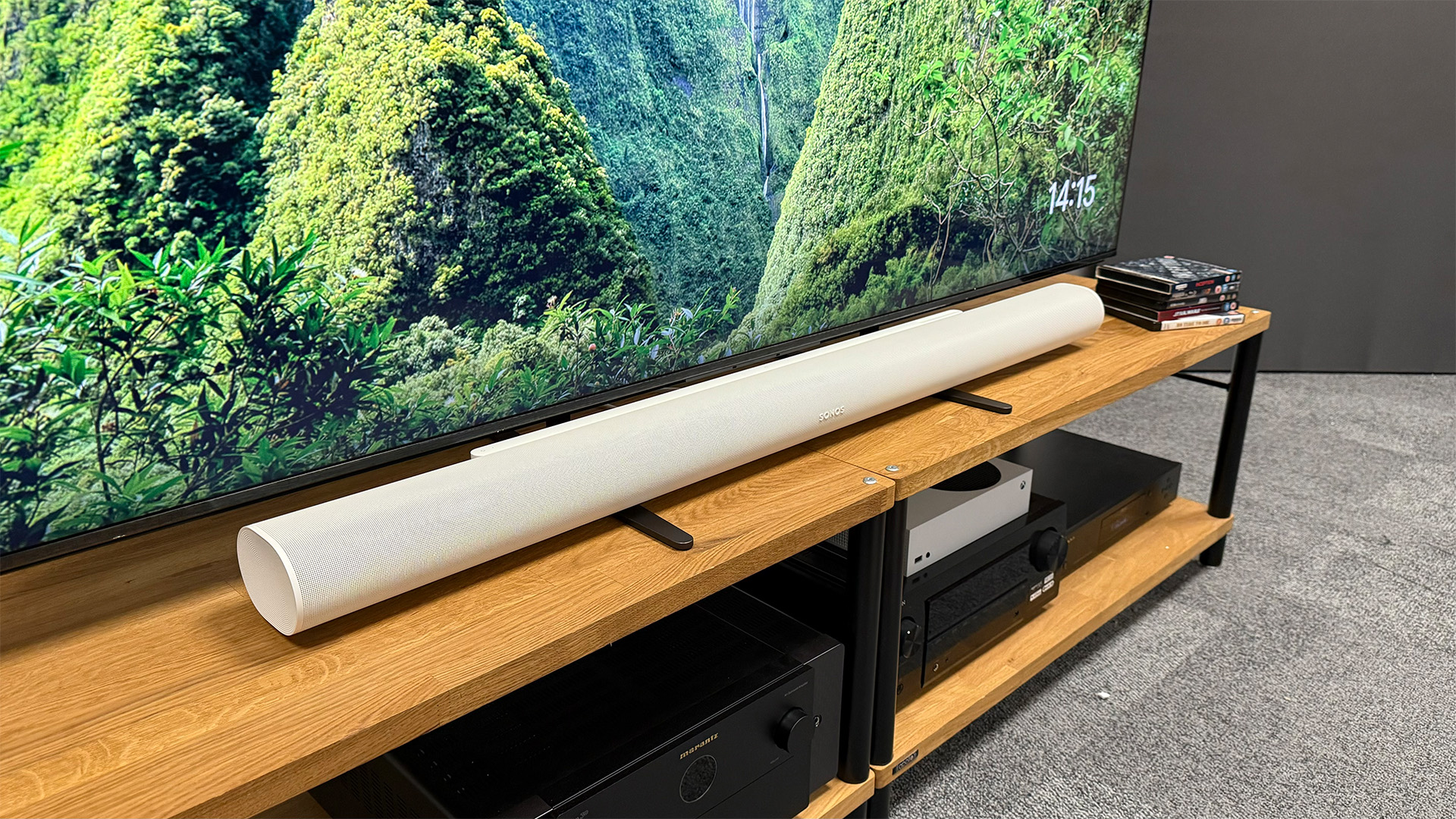What Hi-Fi? Verdict
It’s been a long time in the making but the Arc Ultra was worth the wait – this is a huge upgrade on the still-very-good original Arc
Pros
- +
Clean, precise, spacious and three-dimensional sound
- +
Deep, tuneful and expressive bass
- +
Terrifically detailed for a soundbar
Cons
- -
No HDMI passthrough
- -
No DTS support
- -
Still some app issues
Why you can trust What Hi-Fi?
After months (if not years) of speculation, the replacement for the Sonos Arc is finally here. The Sonos Arc Ultra (aka the Sonos Arc 2) looks very much like its predecessor, but Sonos has some seriously bold claims for its new Dolby Atmos soundbar’s features and performance, saying that it features 'breakthrough’ speaker technology and "up to double the bass" of the original Arc.
Bold claims indeed but, after more than a week of comprehensive, comparative testing, we can confirm that the Arc Ultra is very impressive indeed.
Price
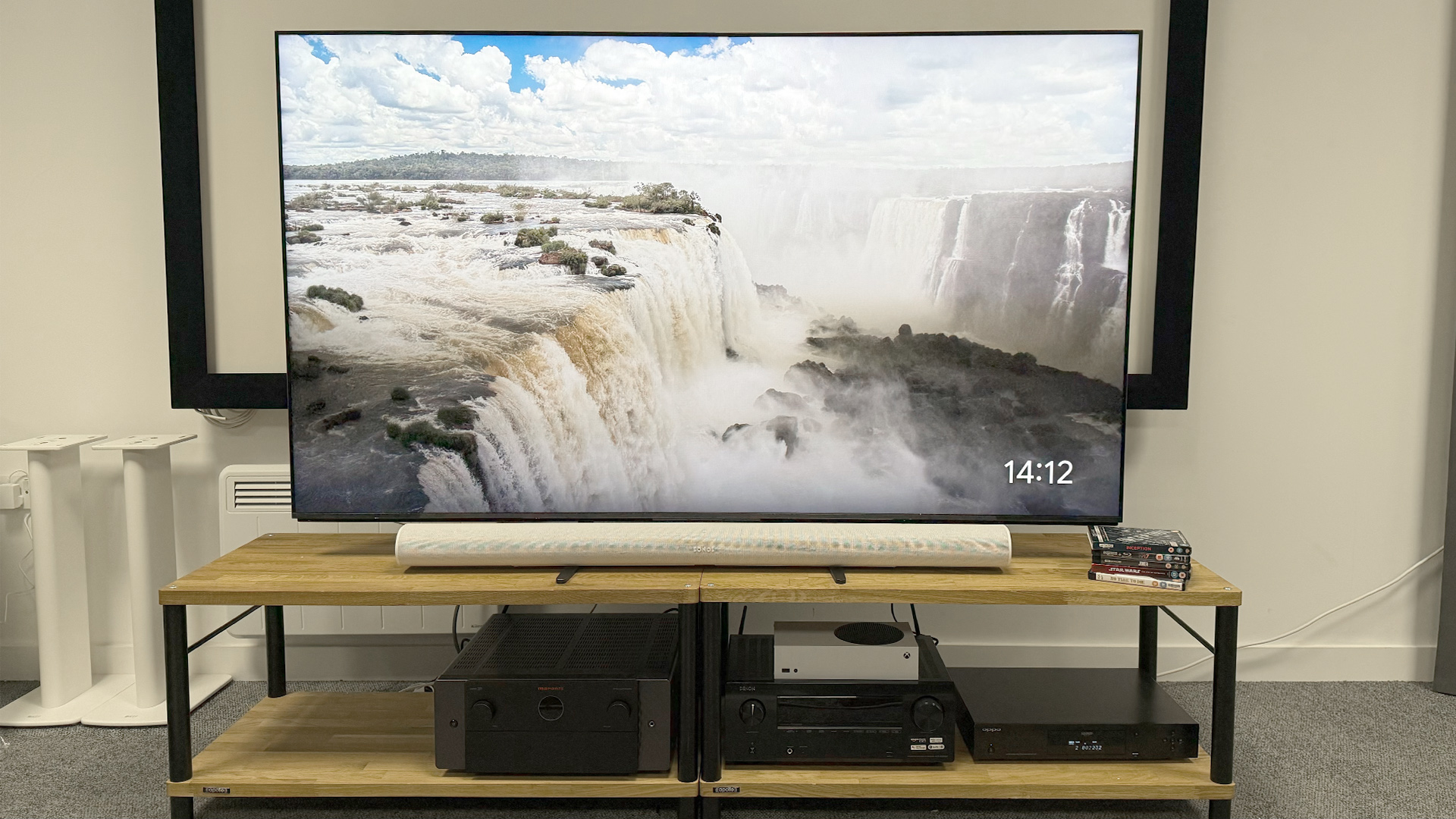
The Sonos Arc Ultra, which hit shops on 29th October, is officially priced at £999 / $999 / AU$1799. That makes the Arc Ultra £100 / $100 / AU$300 more expensive than the official price of the original Arc, but it's worth mentioning that in some regions you can currently get the older model with some very large discounts as it has been discontinued and retailers are keen to shift excess stock.
There are plenty of non-Sonos rivals that should also be considered, most notably the Award-winning Sony Bravia Theatre Bar 9, which is officially a fair bit more expensive (£1399 / $1400 / AU$1795) but is already available from time to time with big discounts. The Samsung HW-Q990D is a new favourite in this category, too. Again, it's a fair bit more expensive than the Arc Ultra, at £1499 / $1400 / AU$1999, but it comes with a wireless subwoofer and wireless surrounds in the box – buy the Arc Ultra with the Sub 4 and a pair of Dolby Atmos-enabled Era 300 speakers in the so-called 'Ultimate Immersive Set with Arc Ultra', and the price rises to £2426 / $2561 / AU£4366.
There are more affordable speakers in the Sonos range that can be used as surrounds and there’s a cheaper subwoofer, the Sub Mini, but on paper, these seem a mismatch for the Arc Ultra. We intend to test the various available combinations at a later date, but you will find our thoughts on the Ultimate Immersive Set with Arc Ultra later on in this review.
Design
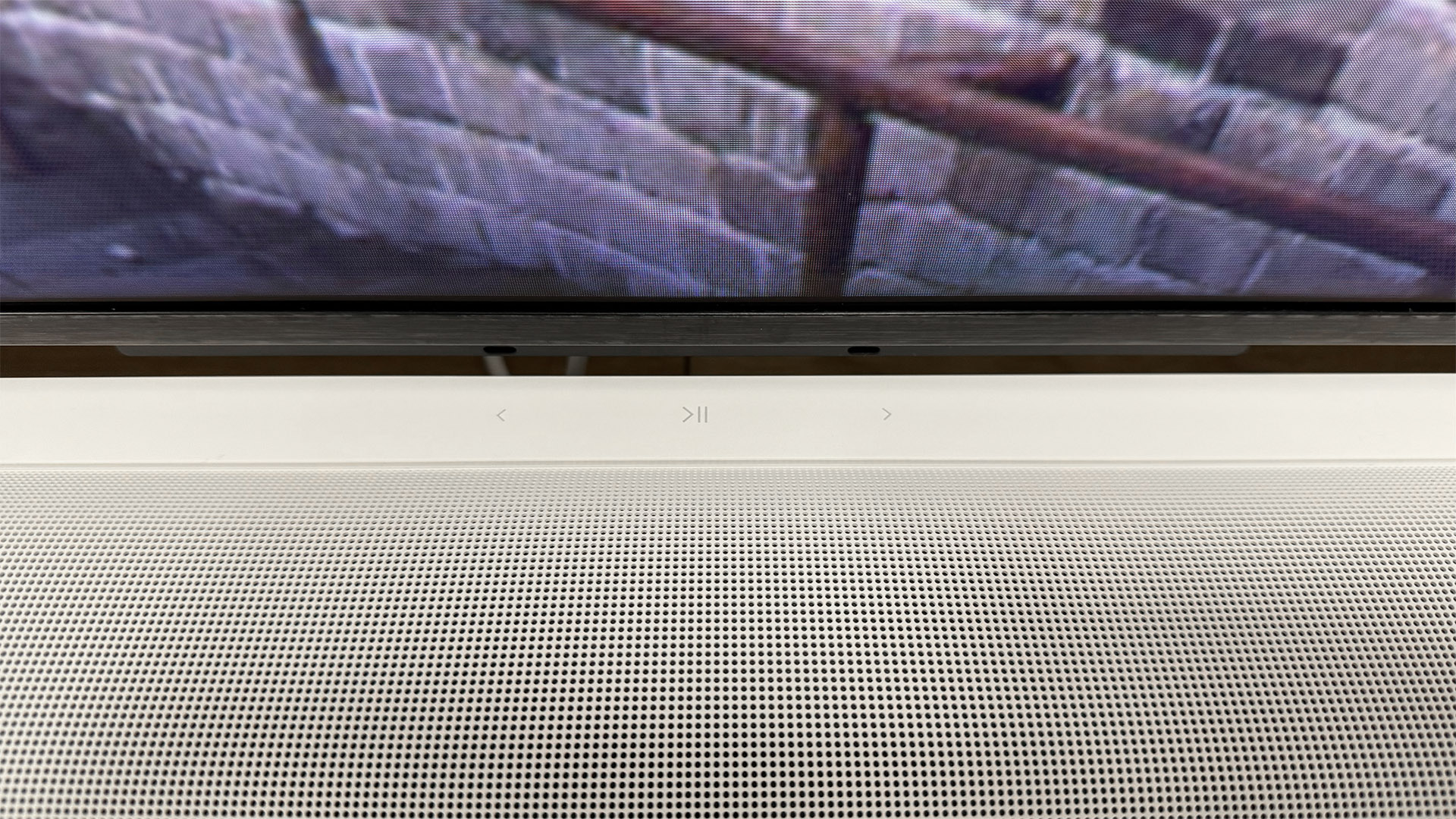
At first glance, it's quite hard to tell the Arc Ultra from the original Arc, but there are some differences in the design, most notably the 'ledge' at the back of the top of the chassis. This houses the touch controls that were integrated into the main grille of the original Arc: play/pause and skip forward/back are in the middle, a volume slider (that can also be tapped) is on the right, and a button to enable or disable voice control is on the left.
The Bluetooth pairing button is hidden in the recess around the back with the HDMI and power ports, which is a bit inconvenient. There is also a physical microphone switch in this recess for those who want to be sure that the soundbar isn’t listening.

Connectivity HDMI out (eARC), wi-fi, Bluetooth 5.3, AirPlay 2
Format support Dolby Atmos
Streaming Spotify Connect, Tidal Connect
Voice control Sonos Voice Control, Amazon Alexa, Google Assistant
Dimensions (hwd) 7.5 x 118 x 11 cm
The dimensions of the Arc Ultra are also subtly different to those of the original Arc: it's a little wider (118cm to 114cm), but it's slightly less tall, too (7.5cm to 8.7cm), making it less likely to obstruct the bottom of your TV's screen if the 'bar is placed in front. Those who are going to wall-mount the soundbar might be pleased to learn that it's also about 350g lighter than the outgoing model.
As with the original Arc, the Arc Ultra is pretty much all grille, with just a Sonos logo and glowing status light breaking up the appearance from the front. This is of course deliberate – by perforating pretty much the entire chassis, Sonos has ensured that sound can emanate from the soundbar in almost any direction.
On that subject, the Arc Ultra will not work properly in a nook or on a shelf with another above it, as this will block the sound emanating from the upper portion of the soundbar.
Features
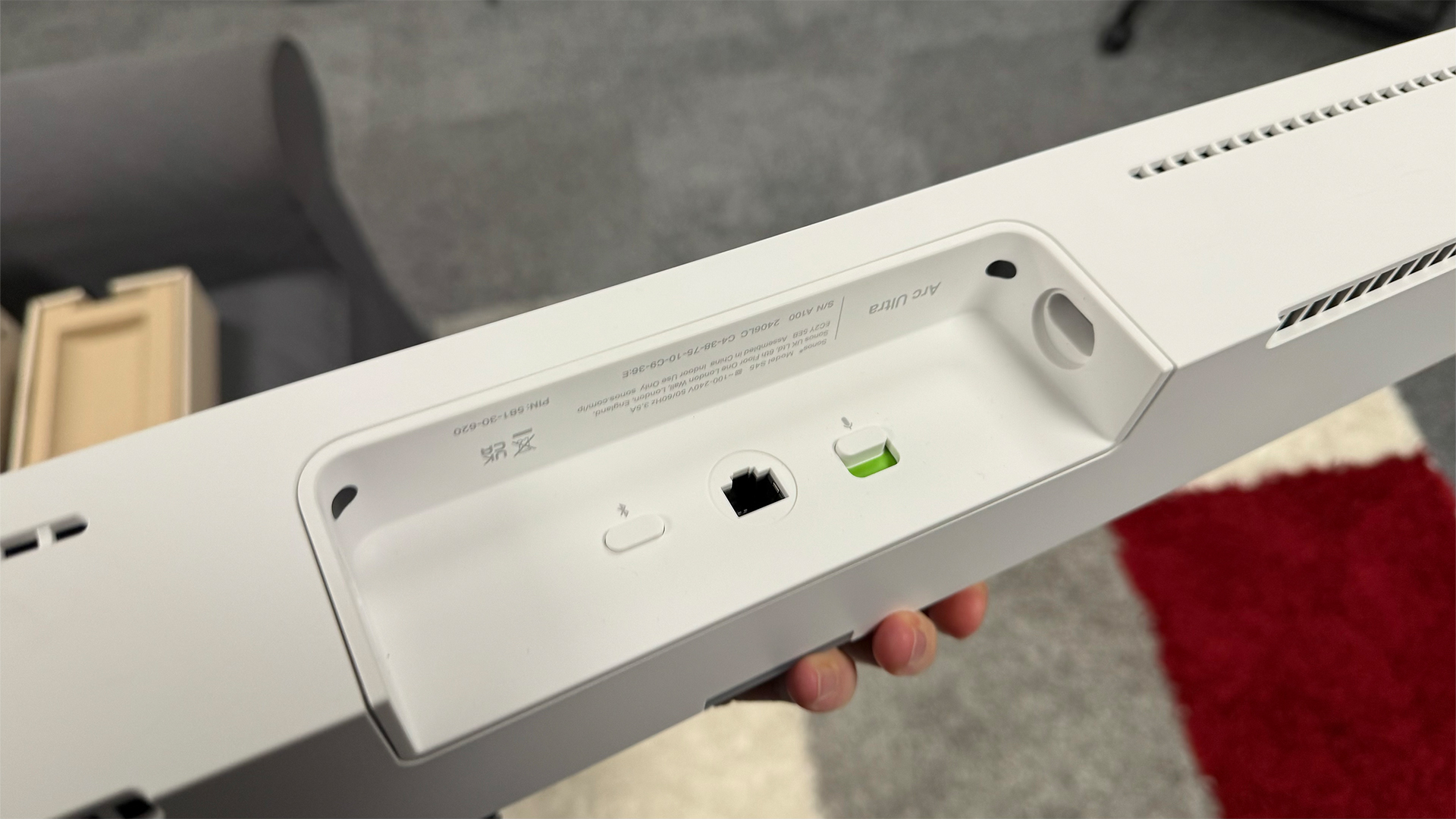
The Arc Ultra boasts a 9.1.4-channel configuration, up from the 5.0.2 arrangement of the original Arc. There are 15 Class D amplifiers powering 14 drivers that are all Sonos-engineered. There are seven tweeters, six midrange woofers, and a 'Sound Motion' woofer, and it's the last of those that's the really big deal.
A typical speaker driver has one, heavy motor, but a Sound Motion driver has four smaller, lightweight motors in opposing corners. Working together, these motors are apparently able to push the cone to shift far more air and produce far more bass. Sonos specifically claims that the Arc Ultra can produce double the bass of the original Arc and "more balanced sound all around". The Sound Motion driver also features dual cones that move in opposite directions to create a force-cancelling effect that apparently "eliminates mechanical vibration".
Sonos says Sound Motion drivers can be three times smaller than standard drivers and yet more powerful, and it's clearly very excited by the possibilities they afford. This "opens a new chapter in sound innovation where bigger, better sound can be delivered from smaller products", it boldly proclaims, while teasing that it "looks forward to introducing more innovative products with sound motion in the future".
While the Sound Motion driver is without a doubt the star of the show, there's also a new front-firing speaker array that apparently improves the centre channel performance to "deliver crisp dialogue". Sonos also says that the front soundstage is further improved through the addition of what Sonos calls "custom colinear waveguides" on the left, centre and right, and there are of course up-firing and side-firing drivers that bounce sound off the walls of your room to deliver that Dolby Atmos effect, which Sonos says is significantly improved for this new model. In fact, it says it delivers "Dolby Atmos like never before", which seems a very bold claim in a world in which Dolby Cinema exists, but what soundbar launch would be complete without a heavy dose of hyperbole?
Unfortunately, Sonos hasn't seen fit to add DTS support of any kind to this new model so, as with the original Arc, Arc Ultra owners will have to make do with Dolby Atmos as the only spatial audio format.
Another disappointment – one that will actually be more acute for many people – is that the Arc Ultra does not have any dedicated HDMI inputs. As with the original Arc, the idea is that you simply connect the soundbar to your TV using eARC, with any external sources being routed through the TV and out to the 'bar. That will be fine for most people, but it will be a real pain in the proverbial for others, particularly those with more than one high-spec gaming device and a TV with just two HDMI 2.1 sockets, as the Arc Ultra will take up one of those.
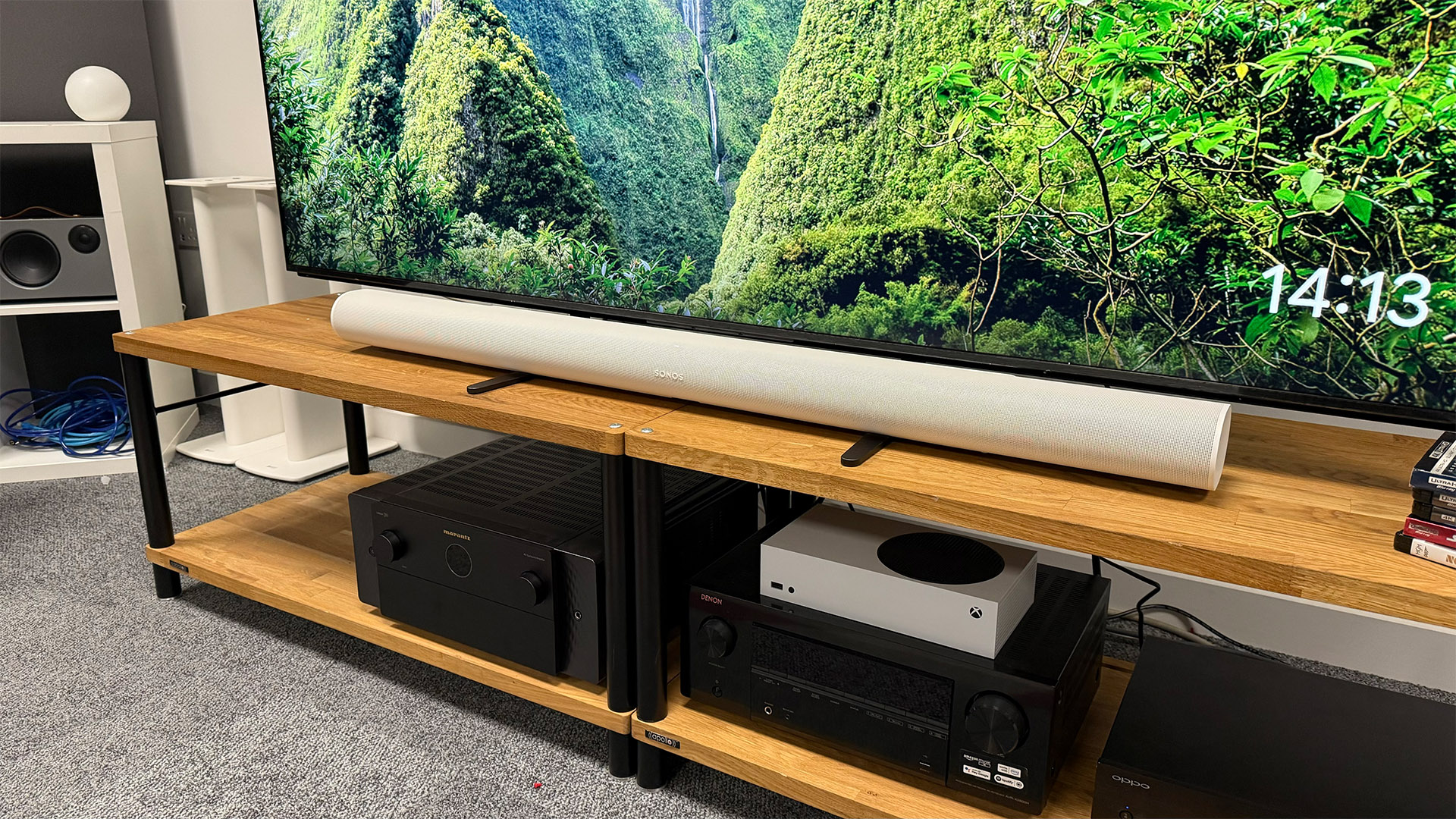
There are a couple of little upgrades, though. Unlike the original Arc, the Arc Ultra supports Bluetooth and, in a Sonos first, the Trueplay calibration process is supported on Android as well as iOS phones.
With the Arc Ultra, Trueplay comes in two flavours – Quick and Advanced. The former is the only one available to Android users and is a single measurement that uses the soundbar’s own microphone, while the latter is the old ‘hoovering-the-walls’ method of before – albeit without the preceding measurement of the seating position. We find that the Quick method makes a big difference to a non-Trueplayed Arc Ultra, with Advanced being only very slightly improved beyond that, so Android users need not feel that they're limited to sub-par sonic delivery.
As you would expect, the Arc Ultra can be controlled via the Sonos app, your TV's remote control, the touch controls on the soundbar itself, or your voice. Of course, Sonos Voice Control is supported as well as Alexa and Google Assistant, and you can in fact have both Sonos Voice Control and Alexa enabled at the same time, allowing you to use them interchangeably depending on what you’re trying to do – Sonos for music controls but Alexa to control your lights or add something to your shopping list, for example. The Google Assistant unfortunately won’t team up with either of its contemporaries.
The app also gives you access to EQ controls and features such as Night mode, which reduces dynamics and bass so that the sound travels less readily between rooms, and Speech Enhancement, which now has different levels so that you can control to what degree the dialogue is projected. It’s also worth mentioning the Loudness setting, which is on by default and should usually be left so, as it adds pep and weight without introducing anything negative, at least in our space. That said, it might be worth trying turning Loudness off if you find the default sound too forthright.
If the Night mode isn’t quiet enough for your sleepy household, meanwhile, Sonos would be delighted to sell you a pair of its Ace headphones, which can take over sound output duties from the Arc Ultra in an instant. In this set-up, the Ace will even do dynamic head-tracking so that it still feels at least somewhat as though you’re listening to a home cinema system.
Of course, no modern Sonos review would be complete without at least a mention of the company’s well-documented app travails. For what it’s worth, the app is no longer awful – but it’s still far from great. Simple controls such as switching the speaker you’re listening to are unintuitively placed and we encounter various bugs during testing, such as the app not registering when a new track is being played via Tidal Connect, tracks simply not playing when being selected through the Sonos app, several failed attempts at Trueplaying an expanded system, and a full freeze when trying to go through the TV set-up process, forcing a restart.
The good news is that many people will find that they need to interact rarely with the Sonos app – music can be sent directly from apps such as Spotify and Tidal and your TV remote will control the Arc Ultra the vast majority of the time. It’s also worth pointing out that we’ve had no issues when accessing features such as the Night mode or the EQ. So, while the Sonos app clearly isn’t very good at the moment, that shouldn’t significantly affect many users.
Sound
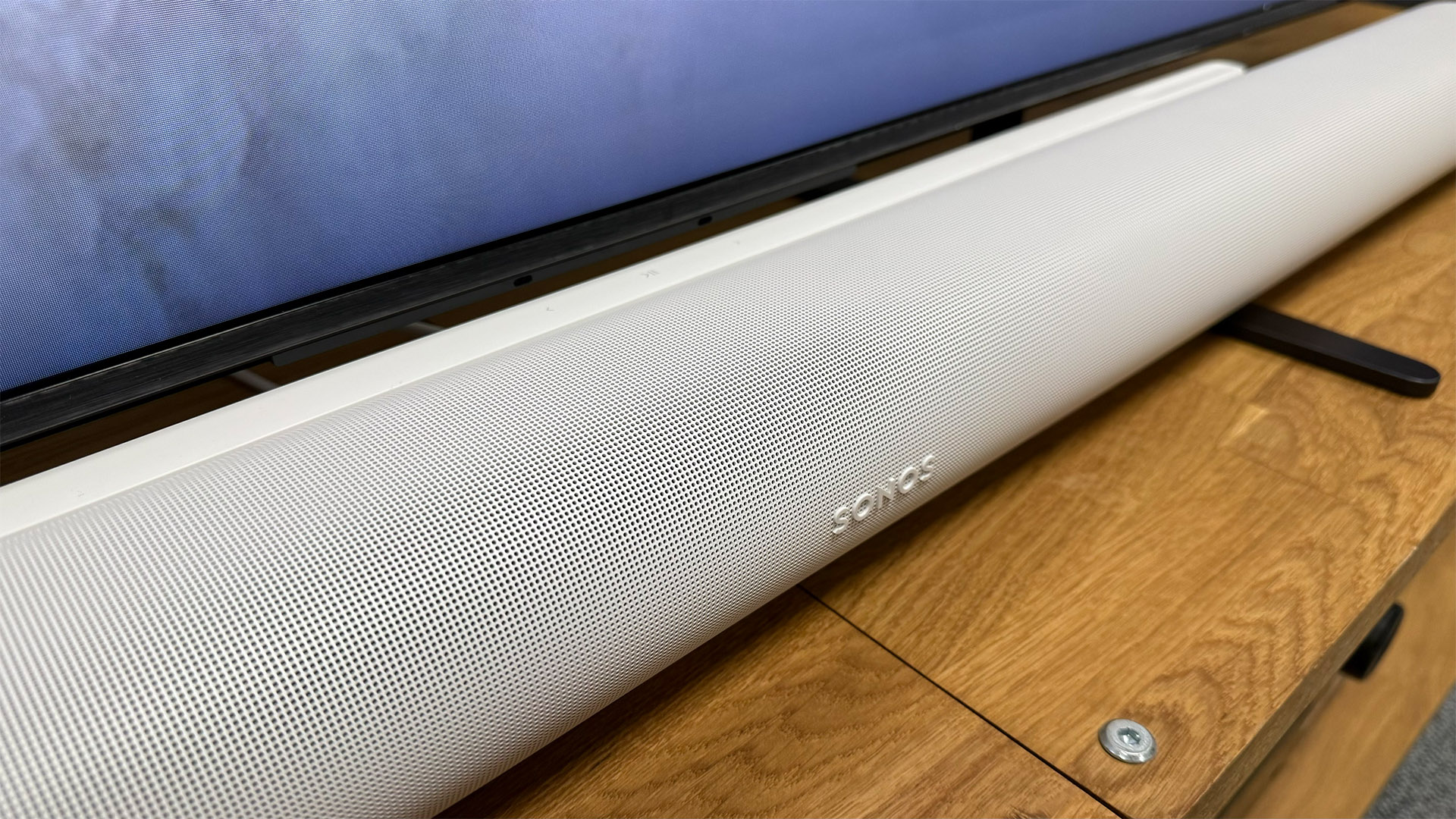
Sonos soundbars have long been among the most musical in the category, and the Arc Ultra further solidifies that reputation. Playing Tool’s Invincible, the step up from the original Arc is striking. Through the first part of the track – the gradual build – there’s a slight but clear improvement to precision, and a crispness and tightness that makes the original Arc sound just a little casual. It sounds more open and airy, too, while never allowing the vocals to move out of focus.
It’s when the track really hits its stride that the upgrades truly shine through, though. That increased precision helps keep everything organised both rhythmically and spatially, even when there’s loads going on, and the bass underpinning it all is markedly better. It’s not so much that there’s loads more bass – the original Arc was already a pretty weighty performer – but more that there's increased tonality and agility to the bottom end. Bass notes hit with greater force and stop more precisely, and they’re tuneful in a way that makes the bass from the original Arc sound somewhat leaden and one-dimensional.
The delivery as a whole is just that bit more energetic, exciting and engaging as a result. It’s a crackingly musical soundbar.
It was inevitable that we would put Sonos’s claims regarding the Arc Ultra’s bass response to the test using chapter two of Blade Runner 2049, and indeed, that’s immediately where we head after a good deal of very enjoyable music-listening. Here, the new Sonos soundbar instantly impresses: there’s no chuffing from the drivers and it has a really good go at the super-deep notes of the soundtrack. One wouldn’t say its grip on the bottom end was cast iron but, for a soundbar, the combination of weight and control is impressive. This is backed up when we switch to the original Arc, which sounds comparatively woolly and overbearing through the same sequence. Again, it’s not the amount of bass that’s really improved for the Arc Ultra, but the quality of it. It’s tight, tuneful and expressive in a way that is rare in the soundbar world.
Really, though, the bass performance is just the start of the Arc Ultra’s qualities. It also boasts very impressive spatial sound-effect placement for a solo bar. The voice of the interrogator during K’s ‘baseline test’ sounds as if it’s coming from above you, the audio adverts outside our protagonist’s apartment building appear in the top-right and top-left of your room, Joi’s disembodied voice inside the apartment moves around the environment and the sound of the rain on the rooftop stretches far beyond the extremities of the TV to which the Ultra is connected.
The sound is very detailed, too. Incidental noises such as footsteps, a tooth being gently placed on a glass table, and the soft squeak of a rubber surgical gown as a character stretches out his arm are all delivered clearly and cleanly but in an unforced manner, contributing to the atmosphere without distracting. The Arc Ultra’s low-level dynamic subtlety helps here, too, in that it ensures those details are presented naturally and realistically. At the other end of the spectrum, grand changes in volume are dispatched without fuss or fluster and the Arc Ultra is capable of going very loud.
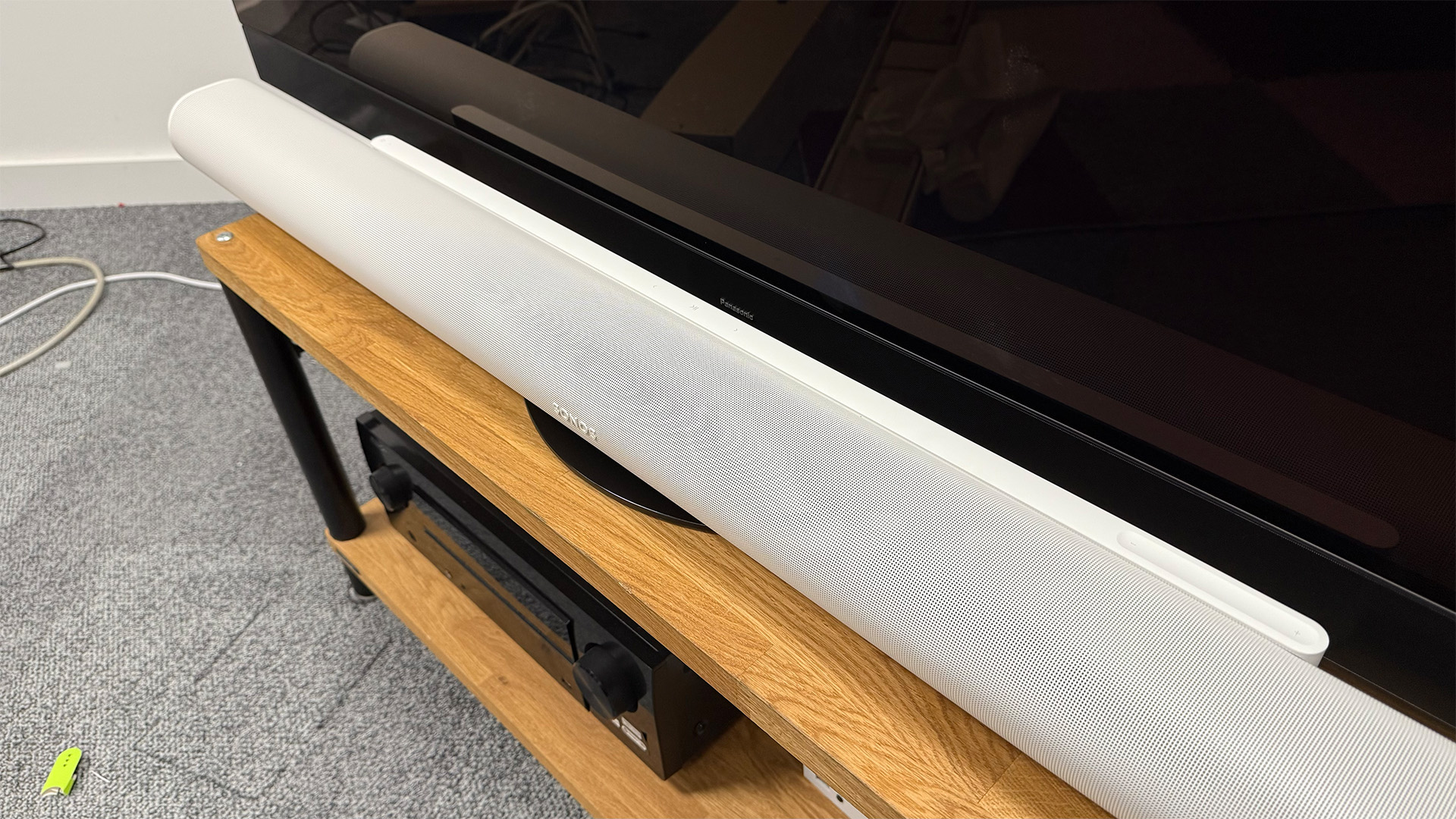
Switching back to the original Arc, we find that voices aren’t projected out and into the room as effectively and there’s less texture and detail to them. The spatial effect is far less pronounced, too, and the audio is comparatively muddled and vague. The step-up is clear, even though the original Arc still sounds like a very good soundbar in its own right.
Of course, the Arc Ultra doesn’t just have to be better than the original Arc; it also needs to be better than its non-Sonos rivals, most notably the Sony Bravia Theatre Bar 9. This comparison is much less clear-cut. The Sony actually extends a little deeper in the bass, but its low end is less tightly defined. It’s also a little less detailed and dynamically nuanced. On the other hand, the Sony is even more open and spacious-sounding than the Sonos. If each soundbar is at its official price, the Arc Ultra is cheaper and therefore the winner, but if they’re available at the same price – as they are in the UK at the time of writing – it becomes a personal preference thing and we recommend that you hear both ’bars before deciding if you can.
If you do choose the Arc Ultra, you might be wondering if you should also extend it through the addition of the new Sub 4 and/or a pair of Atmos-capable Era 300 speakers as surrounds. As mentioned above, the full set-up is very expensive, particularly compared with a system-in-a-box alternative such as the Samsung HW-Q990D – but it’s also deeply impressive. Those three-dimensional Dolby Atmos effects can now be placed anywhere in the room, including right over the listening position, making the experience far more atmospheric and cinematic. Chapter two of Blade Runner 2049 becomes way more weighty and impactful, too, but it’s well-controlled as well. There’s no chuffing from the sub – just added presence and depth. A full review of this system will follow at a later date but, for now, suffice to say it’s extravagant but pretty spectacular.
Verdict
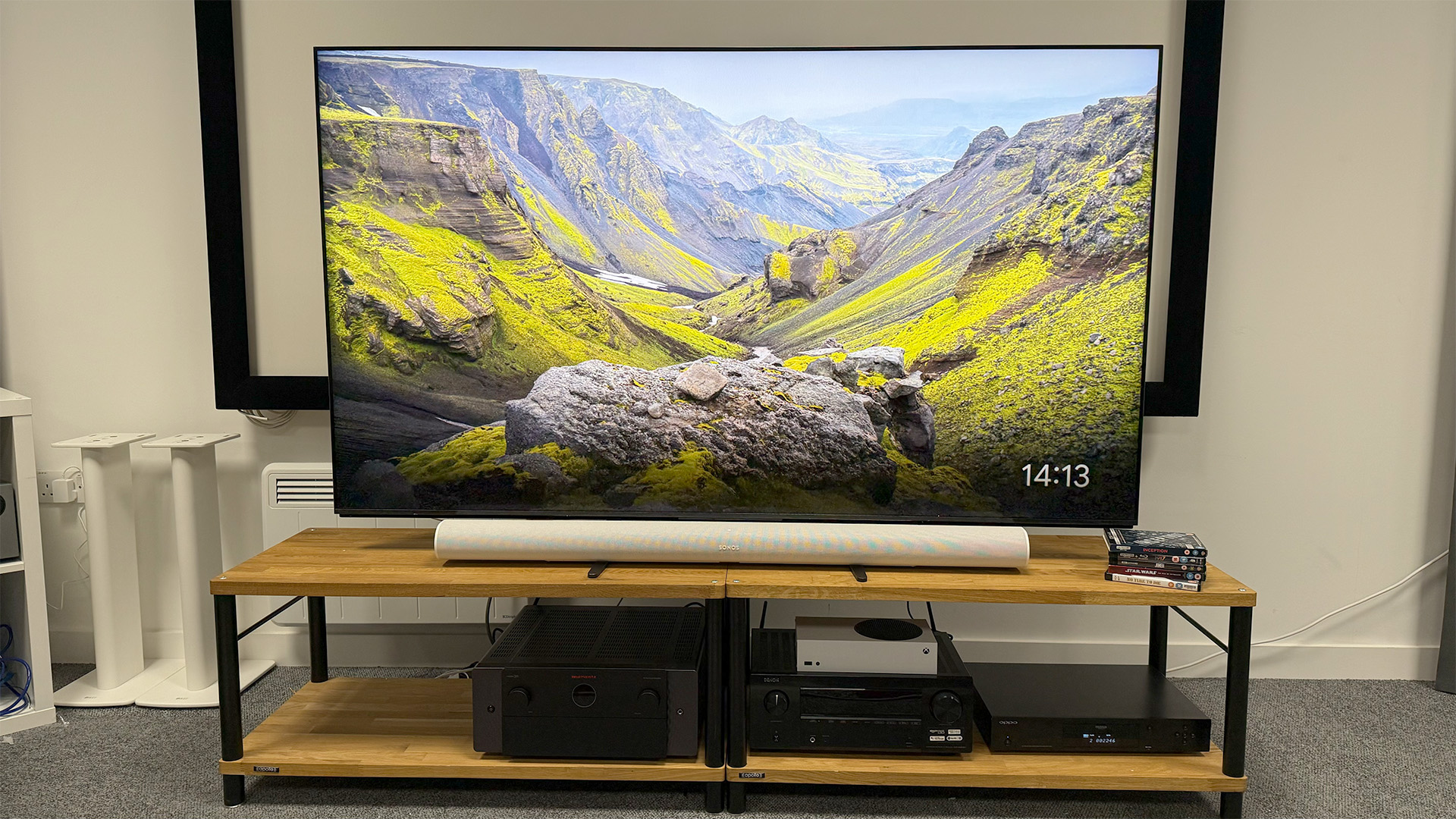
The Sonos Arc Ultra is a hit. Perhaps contrary to expectations, it’s not vastly bassier than the original Arc, but its low end is significantly more controlled, tuneful and better defined. And that’s just the start of the improvements. It really is quite amazing how much more crisp, spacious, precise and detailed the Ultra sounds.
It’s a real disappointment that Sonos hasn’t seen fit to add one or two HDMI 2.1 sockets to its new, flagship soundbar, but if that isn’t an issue for you, the Arc Ultra is a fabulous option.
SCORES
- Sound 5
- Build 5
- Features 3
MORE:
Read our review of the Sonos Arc
Also consider the Sony Bravia Theatre Bar 9
Read our Samsung HW-Q990D review
Best soundbars: options for every need, recommended by our experts
What Hi-Fi?, founded in 1976, is the world's leading independent guide to buying and owning hi-fi and home entertainment products. Our comprehensive tests help you buy the very best for your money, with our advice sections giving you step-by-step information on how to get even more from your music and movies. Everything is tested by our dedicated team of in-house reviewers in our custom-built test rooms in London, Reading and Bath. Our coveted five-star rating and Awards are recognised all over the world as the ultimate seal of approval, so you can buy with absolute confidence.
-
R2D2 Reply
A superb sounding soundbar, there is no such flipping thing if you want decent sound quality!What Hi-Fi? said:Yes, the bass is better, but that’s just the start of the Arc Ultra’s many sonic upgrades.
Sonos Arc Ultra : Read more -
manicm ReplyR2D2 said:A superb sounding soundbar, there is no such flipping thing if you want decent sound quality!
Actually there is, I've owned two, and they both sounded great in their own right. -
joaotab Not sure if part of the review was copy pasted from the Arc or AI generated but Sonos doesn't support Google Assistant ever since the Eras were launched, due to the ongoing patent disputes...Reply -
aliabi Hello,Reply
I did the upgrade from Arc to Arc Ultra... I am not sure it is worth "yet" :rolleyes:
In Home Cinema viewing it is better than the ARC but not impressive (because the ATMOS depends really on the encoding quality and your room we have very high ceilings). After the True sound setup I added more height in the app. so you may have more of an enveloping effect but nothing spectacular.
I had and did some test with Samsung 990C this was impressive but I disliked very much listening to the music with it. Because we use the Sonos for Movies and Music and have other products, I decided to keep the Sonos.
But even the music is a bit less appealing to me. The ARC Ultra has a very clear and detailed sound less "soft" or "round" sonority, so it will depend the kind of music you are listening (it reminds me Yamaha home theater sounds which I had before switching to Denon amp before sounds bars :)...).
I found the old ARC very easy going no adjustment needed after the setup. In 3 years I never touched the settings for any style of music (after adding the sub).
So in my humble opinion and as a Sonos fan, I still recommend to wait or maybe add sub (game changer) or surround options if you just have the good old Sonos Arc as we say in french:
c’est dans les vieux pots qu’on fait la meilleure soupe (it’s in old pots that we make the best soup) -
R2D2 Reply
WhatHiFi did say the cheaper Arc was the better deal when it was on offer.aliabi said:Hello,
I did the upgrade from Arc to Arc Ultra... I am not sure it is worth "yet" :rolleyes:
In Home Cinema viewing it is better than the ARC but not impressive (because the ATMOS depends really on the encoding quality and your room we have very high ceilings). After the True sound setup I added more height in the app. so you may have more of an enveloping effect but nothing spectacular.
I had and did some test with Samsung 990C this was impressive but I disliked very much listening to the music with it. Because we use the Sonos for Movies and Music and have other products, I decided to keep the Sonos.
But even the music is a bit less appealing to me. The ARC Ultra has a very clear and detailed sound less "soft" or "round" sonority, so it will depend the kind of music you are listening (it reminds me Yamaha home theater sounds which I had before switching to Denon amp before sounds bars :)...).
I found the old ARC very easy going no adjustment needed after the setup. In 3 years I never touched the settings for any style of music (after adding the sub).
So in my humble opinion and as a Sonos fan, I still recommend to wait or maybe add sub (game changer) or surround options if you just have the good old Sonos Arc as we say in french:
c’est dans les vieux pots qu’on fait la meilleure soupe (it’s in old pots that we make the best soup)
